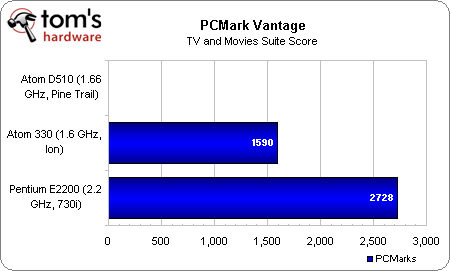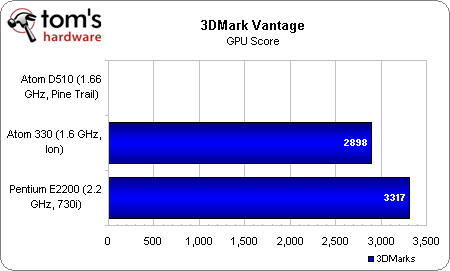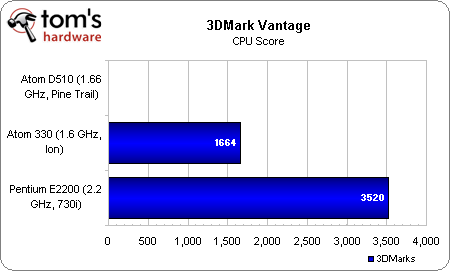Intel’s Atom D510 And NM10 Express: Down The Pine Trail With D510MO
Benchmark Results: Synthetics
PCMark Vantage-based testing starts off a little rocky for Intel’s Pine Trail reference platform, which consistently crashes part-way through the suite.
The processor and graphics technically meet Futuremark’s minimum requirements (minus the Shader Model 3.0-compliant hardware needed for the GPU image manipulation test), so it’s odd that we couldn’t get a complete run in. But we’ll leave it up to the real-world tests to tell us what to expect from Pine Trail, rather than this synthetic.
Between an Atom 330/Ion combination and Intel’s Pentium E2200 and an nForce 730i-based motherboard, however, the victor is clear. The real question is whether you want to pay $150+ for a more powerful microATX setup or $150+ on a slower mini-ITX configuration.
Pine Trail’s inability to compete yet again is less of a surprise in 3DMark Vantage, which requires a DirectX 10-compatible graphics solution. The GMA 3150 core built in to the Atom D510 CPU only does DirectX 9 support.
From there, we’re able to see the Pentium processor helping Nvidia’s nForce 730i outperform Nvidia’s Ion integrated graphics implementation. The Ion setup’s G86 GPU is clocked at 450 MHz with 1,100 MHz shaders. The 730i’s core also runs at 450 MHz, but features 1,200 MHz shaders. Clearly, it’s the more muscular CPU pushing one GPU over the other here.
The 1.66 GHz Atom D510 is just a hair quicker than the 1.6 GHz Atom 330, seen in the SiSoftware Sandra 2010 Arithmetic and Multimedia tests. Meanwhile, you can clearly see the theoretical advantage held by Intel’s 2.2 GHz Pentium E2200.
More interesting, perhaps, is that the bandwidth test shows very minor gains attributable to the on-die memory controller. Granted, we’re talking about a single channel of DDR2-800, but we would have thought that the in-order architecture would have lent itself to taking better advantage of this evolutionary design element. With that said, Nvidia’s memory controller gets less overall utilization out of its dual-channel arrangement, armed with the same DDR2-800 modules.
Get Tom's Hardware's best news and in-depth reviews, straight to your inbox.
Current page: Benchmark Results: Synthetics
Prev Page Test Setup And Benchmarks Next Page Benchmark Results: Transcoding-
It certainly is an improvement over the weak hearted Atom but I was expecting a bit more bang for the CPU's capabilities. Hopefully this will make Mini-ITX boards cheaper and more readily available for small servers and back up applications.Reply
-
scook9 My dad was looking at netbooks because he wanted something portable. What he ended up buying was the Dell Inspiron Mini 11z (not normally an inspiron fan). It has a Pentium Dual Core and the GM45 chipset (with HDMI output not VGA). This little 11" notebook gets over 6 hours of battery life and will run circles around either generation of atom processors and their chipsets/graphics. Yes the 11z did cost more than the other netbooks, but you got alot more for it, something to think about :)Reply -
matt87_50 wow, thats pretty terrible, one wonders how much better that new cpu integrated graphics is than the old chip set integrated? as basic as the ion system is, you can do anything with it, media center decoding HD, playing a couple of games, and as a file server, all with the lowest power consumption, this new one seems like its only good for the latter, and its only 3W less power.Reply
however, a file server / NAS alternative with the lowest possible power consumption is exactly what I'm after, so maybe its perfect for me, but I'd probably still go ION just because of the flexibility it offers in the future, should I get a new file server to replace it.
as for netbooks. If its a computer, I wanna be able to play games on it, and lets not forget about flash going 3D and hardware accelerated, I'd still go ION.
honestly, I wonder how they could make a GPU that crap in this day and age, the one in the iPhone and droid would be more powerful... -
little-ninja-man I just hop with this lower power usage we might see dual core atoms in netbooksReply -
liquidsnake718 I guess its not bad for beginners. I also have a netbook as my 3rd option.... I am rather enjoying the portability and functionality. As a HTCP or mini media center this sounds interesting for beginners that dont know how to build a PC... its almost plug and play..... this is a good option for them. I would prefer to get a mini-ITX board with at least a core 2 duo and build from there...... but then again, a PS2 is currently the king of this realm and you cannot compare as it has an HDMI, Great games, blu-ray, wifi, and everything one would need in this segment. Sorry the Cell is still far superior in this field!Reply -
tacoslave http://www.newegg.com/Product/Product.aspx?Item=N82E16813128342Reply
http://www.newegg.com/Product/Product.aspx?Item=N82E16819103706
quad core plus micro atx = amd win
-
djiezes Lack of HDMI, DVI or hardware accelerated decoding for MPEG4, x264 or h264 really does not make sense for a CPU/chipset that orients itself towards the desktop.Reply
Originally I thought this new chip might've made sense for htpc use. ION still beats it & ION2 is coming soon. An ordinary low powered desktop CPU for htpc use still makes more sense. AMDs Athlon X2 240E for example (45W) or maybe an Intel Pentium E3200 or alike. -
djiezes Lack of HDMI, DVI or hardware accelerated decoding for MPEG4, x264 or h264 really does not make sense for a CPU/chipset that orients itself towards the desktop.Reply
Originally I thought this new chip might've made sense for htpc use. ION still beats it & ION2 is coming soon. An ordinary low powered desktop CPU for htpc use still makes more sense. AMDs Athlon X2 240E for example (45W) or maybe an Intel Pentium E3200 or alike. -
yankeeDDL I have a question regarding the power efficiency. We see that in most tasks the Atoms are about 2X slower than the Pentium, and it seems to consume about 3~3,5X less under load.Reply
I wonder if a real/fair comparison of power consumption should be made differently.
For example: if I watch a DVD on an Atom I need, say, 100% CPU, while on a Pentium I will need only 50% of it.
So I will have the Atom burning power under full load vs 50% of the Pentium.
In other words: the Pentium is much more powerful, so it does not need to run full speed to do the same.
So, is there really an advantage in the Atom? Can you get the power/performance ratio of an Atom by simply underclocking a Pentium by few %?










